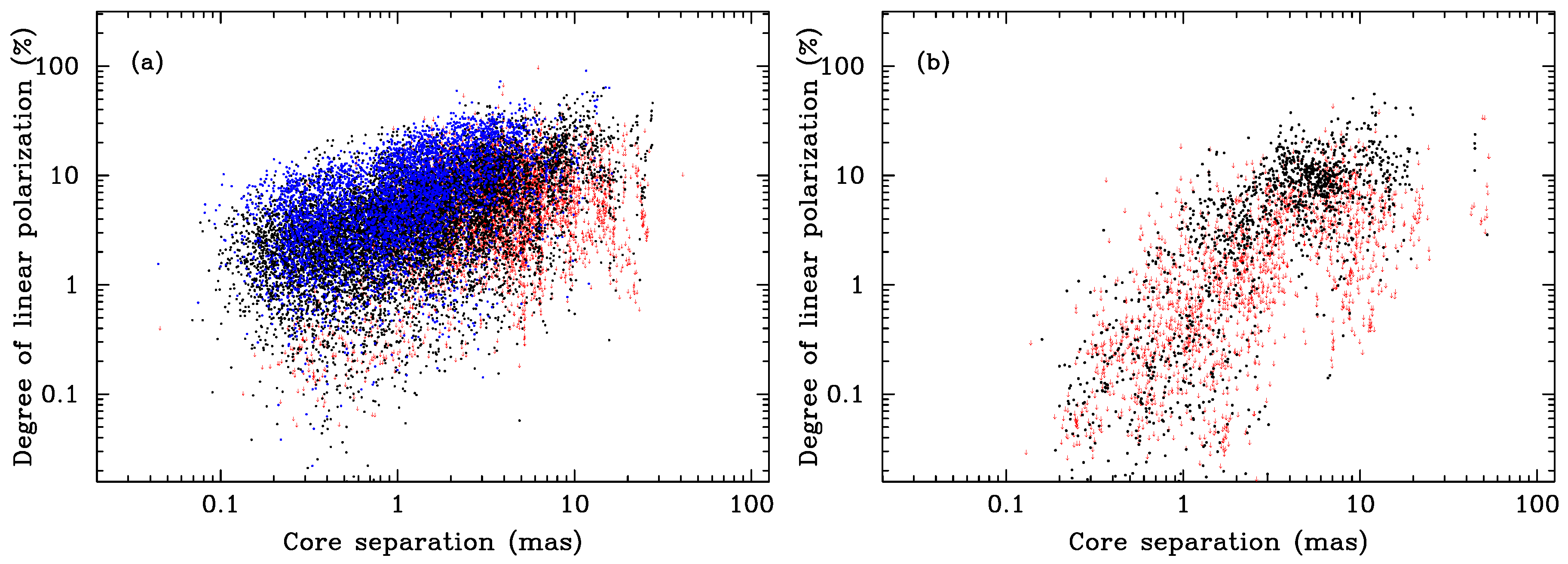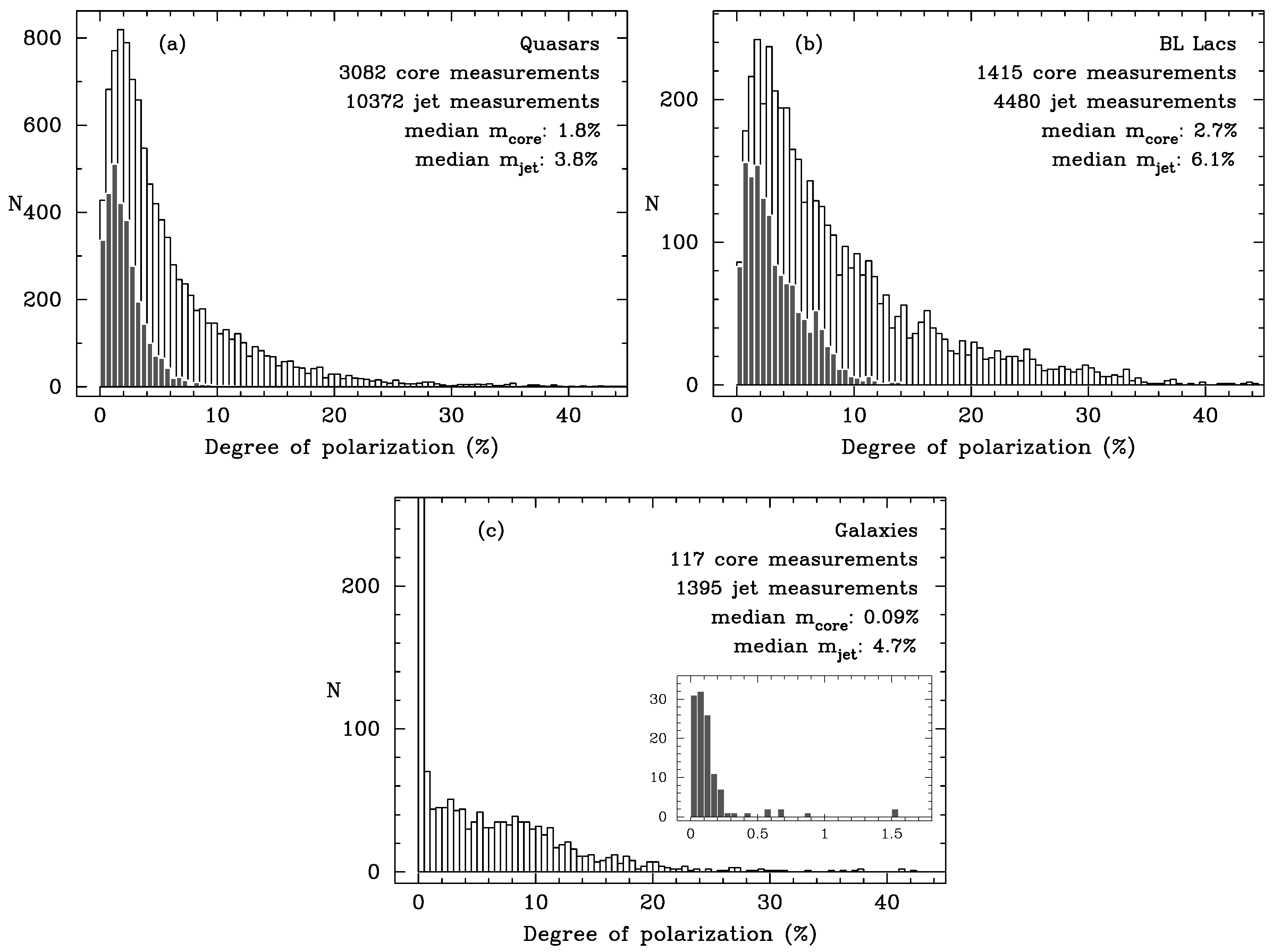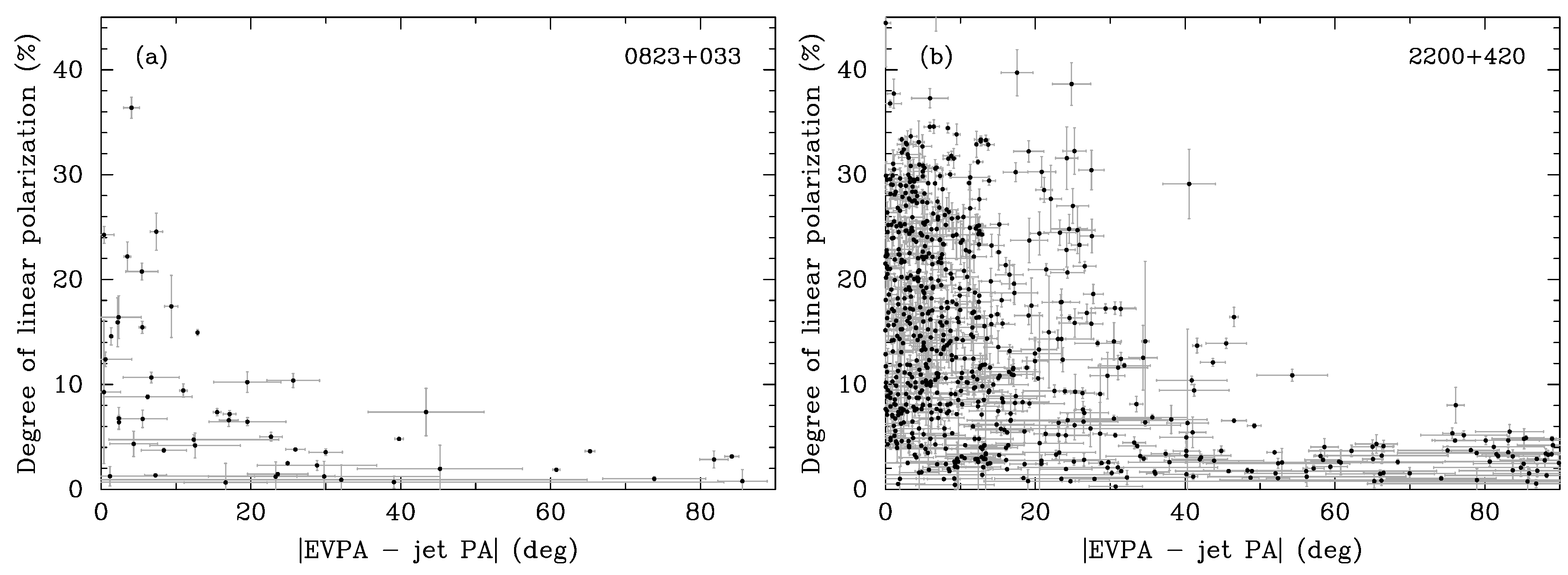Linear Polarization Properties of Parsec-Scale AGN Jets †
Abstract
:1. Introduction
2. Observational Data and the Sample
3. Results
4. Discussion
Acknowledgments
Author Contributions
Conflicts of Interest
Abbreviations
| AGN | Active Galactic Nucleus |
| AIPS | Astronomical Image Processing System |
| EVPA | Electric Vector Position Angle |
| MOJAVE | Monitoring Of Jets in Active galactic nuclei with VLBA Experiments |
| NRAO | National Radio Astronomy Observatory |
| SED | Spectral Energy Distribution |
| VLBA | Very Long Baseline Array |
References
- Lister, M.L.; Cohen, M.H.; Homan, D.C.; Kadler, M.; Kellermann, K.I.; Kovalev, Y.Y.; Ros, E.; Savolainen, T.; Zensus, J.A. MOJAVE: Monitoring of Jets in Active Galactic Nuclei with VLBA Experiments. VI. Kinematics Analysis of a Complete Sample of Blazar Jets. Astron. J. 2009, 138, 1874–1892. [Google Scholar] [CrossRef]
- Lister, M.L.; Aller, M.F.; Aller, H.D.; Hovatta, T.; Max-Moerbeck, W.; Readhead, A.C.S.; Richards, J.L.; Ros, E. Why Have Many of the Brightest Radio-loud Blazars Not Been Detected in Gamma-Rays by Fermi? Astrophys. J. Lett. 2015, 810. [Google Scholar] [CrossRef]
- Lister, M.L.; Aller, M.; Aller, H.; Hovatta, T.; Kellermann, K.I.; Kovalev, Y.Y.; Meyer, E.T.; Pushkarev, A.B.; Ros, E.; Ackermann, M.; et al. γ-ray and Parsec-Scale Jet Properties of a Complete Sample of Blazars from the MOJAVE Program. Astrophys. J. Lett. 2011, 742. [Google Scholar] [CrossRef]
- Kellermann, K.I.; Vermeulen, R.C.; Zensus, J.A.; Cohen, M.H. Sub-Milliarcsecond Imaging of Quasars and Active Galactic Nuclei. Astron. J. 1998, 115, 1295–1318. [Google Scholar] [CrossRef]
- Lister, M.L.; Aller, M.F.; Aller, H.D.; Homan, D.C.; Kellermann, K.I.; Kovalev, Y.Y.; Pushkarev, A.B.; Richards, J. MOJAVE. X. Parsec-scale Jet Orientation Variations and Superluminal Motion in Active Galactic Nuclei. Astron. J. 2013, 146. [Google Scholar] [CrossRef]
- Hartman, R.C. The Third EGRET Catalog of High-Energy Gamma-Ray Sources. Astrophys. J. Suppl. Ser. 1999, 123, 79–202. [Google Scholar] [CrossRef]
- Acero, F.; Ackermann, M.; Ajello, M.; Albert, A.; Atwood, W.B.; Axelsson, M.; Baldini, L.; Ballet, J.; Barbiellini, G.; Bastieri, D.; et al. Fermi Large Area Telescope Third Source Catalog. Astrophys. J. Suppl. Ser. 2015, 218. [Google Scholar] [CrossRef]
- Shepherd, M.C. Difmap: An Interactive Program for Synthesis Imaging. In Astronomical Data Analysis Software and Systems VI; A.S.P. Conference Series; Hunt, G., Payne, H.E., Eds.; Astronomical Society of the Pacific: San Francisco, CA, USA, 1997; Volume 125, p. 77. [Google Scholar]
- Lister, M.L.; Aller, M.F.; Aller, H.D.; Hodge, M.A.; Homan, D.C.; Kovalev, Y.Y.; Pushkarev, A.B.; Savolainen, T. MOJAVE: XV. VLBA 15 GHz Total Intensity and Polarization Maps of 437 Parsec-Scale AGN Jets from 1996–2017. Astrophys. J. Suppl. Ser. 2017, in press. [Google Scholar]
- Pushkarev, A.B.; Kovalev, Y.Y.; Lister, M.L.; Savolainen, T. MOJAVE-XIV. Shapes and opening angles of AGN jets. Mon. Not. R. Astron. Soc. 2017, 468, 4992–5003. [Google Scholar] [CrossRef]
- Gabuzda, D.C.; Pushkarev, A.B.; Cawthorne, T.V. Analysis of λ = 6 cm VLBI polarization observations of a complete sample of northern BL Lacertae objects. Mon. Not. R. Astron. Soc. 2000, 319, 1109–1124. [Google Scholar] [CrossRef]
- Lister, M. L.; Homan, D.C. MOJAVE: Monitoring of Jets in Active Galactic Nuclei with VLBA Experiments. I. First-Epoch 15 GHz Linear Polarization Images. Astron. J. 2005, 130, 1389–1417. [Google Scholar] [CrossRef]
- Pushkarev, A.B.; Gabuzda, D.C.; Vetukhnovskaya, Y.N.; Yakimov, V.E. Spine-sheath polarization structures in four active galactic nuclei jets. Mon. Not. R. Astron. Soc. 2005, 356, 859–871. [Google Scholar] [CrossRef]
- Böttcher, M. Spectral and Polarization Signatures of Relativistic Shocks in Blazars. Galaxies 2016, 4. [Google Scholar] [CrossRef]
- Deller, A.T.; Brisken, W.F.; Phillips, C.J.; Morgan, J.; Alef, W.; Cappallo, R.; Middelberg, E.; Romney, J.; Rottmann, H.; Tingay, S.J.; et al. DiFX-2: A More Flexible, Efficient, Robust, and Powerful Software Correlator. Publ. Astron. Soc. Pac. 2011, 123, 275–287. [Google Scholar] [CrossRef]




© 2017 by the authors. Licensee MDPI, Basel, Switzerland. This article is an open access article distributed under the terms and conditions of the Creative Commons Attribution (CC BY) license (http://creativecommons.org/licenses/by/4.0/).
Share and Cite
Pushkarev, A.B.; Kovalev, Y.Y.; Lister, M.L.; Savolainen, T.; Aller, M.F.; Aller, H.D.; Hodge, M.A. Linear Polarization Properties of Parsec-Scale AGN Jets. Galaxies 2017, 5, 93. https://doi.org/10.3390/galaxies5040093
Pushkarev AB, Kovalev YY, Lister ML, Savolainen T, Aller MF, Aller HD, Hodge MA. Linear Polarization Properties of Parsec-Scale AGN Jets. Galaxies. 2017; 5(4):93. https://doi.org/10.3390/galaxies5040093
Chicago/Turabian StylePushkarev, Alexander B., Yuri Y. Kovalev, Matthew L. Lister, Tuomas Savolainen, Margo F. Aller, Hugh D. Aller, and Mary A. Hodge. 2017. "Linear Polarization Properties of Parsec-Scale AGN Jets" Galaxies 5, no. 4: 93. https://doi.org/10.3390/galaxies5040093





